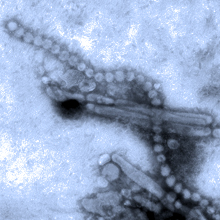Clues in H7N9 Influenza Genetic Sequences
Clues in H7N9 Influenza Genetic Sequences
Researchers quickly evaluated the genetic sequences of the novel H7N9 avian influenza virus that’s caused illness and death in China in recent weeks. The analysis provides clues to the virus’s origin, transmissibility and potential sensitivity to existing treatments.

Transmission electron micrograph of the new influenza A (H7N9) virus. Courtesy of Cynthia S. Goldsmith and Thomas Rowe, Centers for Disease Control and Prevention.
Influenza, or flu, claims thousands of lives nationwide each year. Health experts have been particularly concerned about the threat posed by avian flu viruses. Influenza viruses constantly change, or mutate. Flu pandemics can arise when novel avian strains acquire 2 abilities—to infect humans and to spread easily between people. That’s why health experts keep a close watch on novel viruses.
On March 31, 2013, the Chinese Center for Disease Control and Prevention (Chinese CDC) reported the first cases associated with the H7N9 influenza virus. As of April 21, 2013, 104 human infections had been confirmed, with 21 deaths. To date, the outbreak has been limited to eastern China, and there’s been no evidence of transmission between people.
A team of researchers set out to analyze the novel virus. They were led by Dr. Masato Tashiro of the National Institute of Infectious Diseases in Japan and Dr. Yoshihiro Kawaoka of the University of Wisconsin-Madison and the University of Tokyo. The team studied the genetic sequences of viruses isolated from 4 of the earliest fatal cases. Sequences were provided by the Chinese CDC. The analysis was funded by NIH’s National Institute of Allergy and Infectious Diseases (NIAID) and Japanese organizations. Results appeared on April 11, 2013, in Eurosurveillance.
Influenza virus strains are classified and named based on the viral surface proteins hemagglutinin (HA) and neuraminidase (NA). The combination of H7 HA and N9 NA has previously been seen only in birds. The scientists concluded that the novel strain likely got its surface protein genes from the H7N3 and H11N9 avian influenza strains. Other genes came from H9N2 influenza viruses recently circulating in poultry in China.
While H7N9 causes mild disease in birds, the analysis revealed mutations that may allow it to more efficiently cause disease in mammals. The HA sequences have mutations that have been shown to improve the virus’s ability to bind to human cells. The sequences also contain mutations associated with improved virus reproduction within human cells and with more severe disease in mammals.
The researchers found that the novel H7N9 viruses are likely to be treatable using NA inhibitors, a class of anti-influenza drugs that includes oseltamivir (Tamiflu) and zanamivir (Relenza). However, the novel strain won’t likely be treatable with ion channel inhibitors, another major class of anti-influenza drugs.
“The H7N9 influenza virus is a new concern that the public health and scientific communities will continue to track closely, including watching for any genetic mutations that might enable the virus to become transmissible from person to person or to cause more severe disease,” says NIAID Director Dr. Anthony Fauci. “Having rapid access to the viral genetic information is essential to understanding how the virus is evolving and ultimately to developing a candidate vaccine, if warranted.”
###
* The above story is reprinted from materials provided by National Institutes of Health (NIH)
** The National Institutes of Health (NIH) , a part of the U.S. Department of Health and Human Services, is the nation’s medical research agency—making important discoveries that improve health and save lives. The National Institutes of Health is made up of 27 different components called Institutes and Centers. Each has its own specific research agenda. All but three of these components receive their funding directly from Congress, and administrate their own budgets.




















